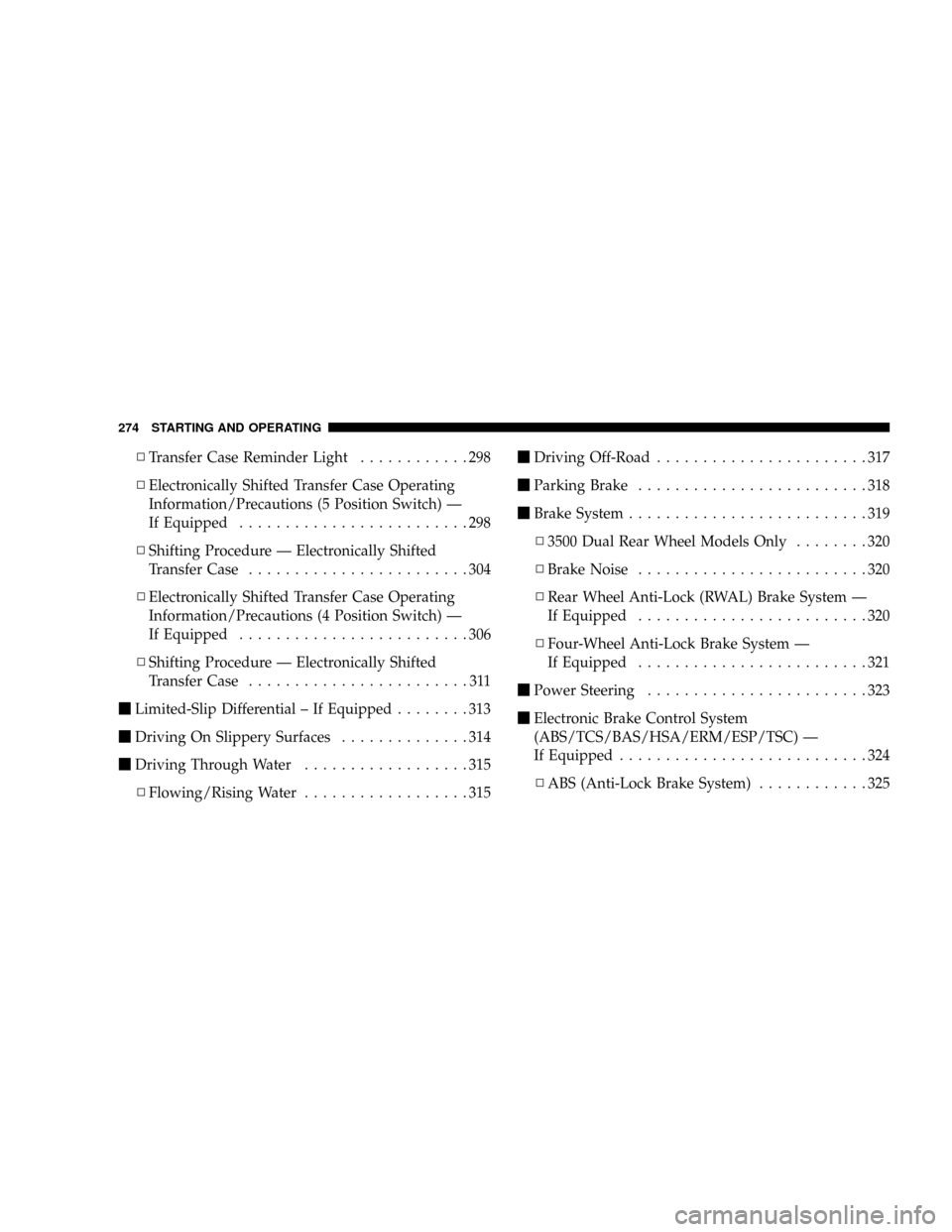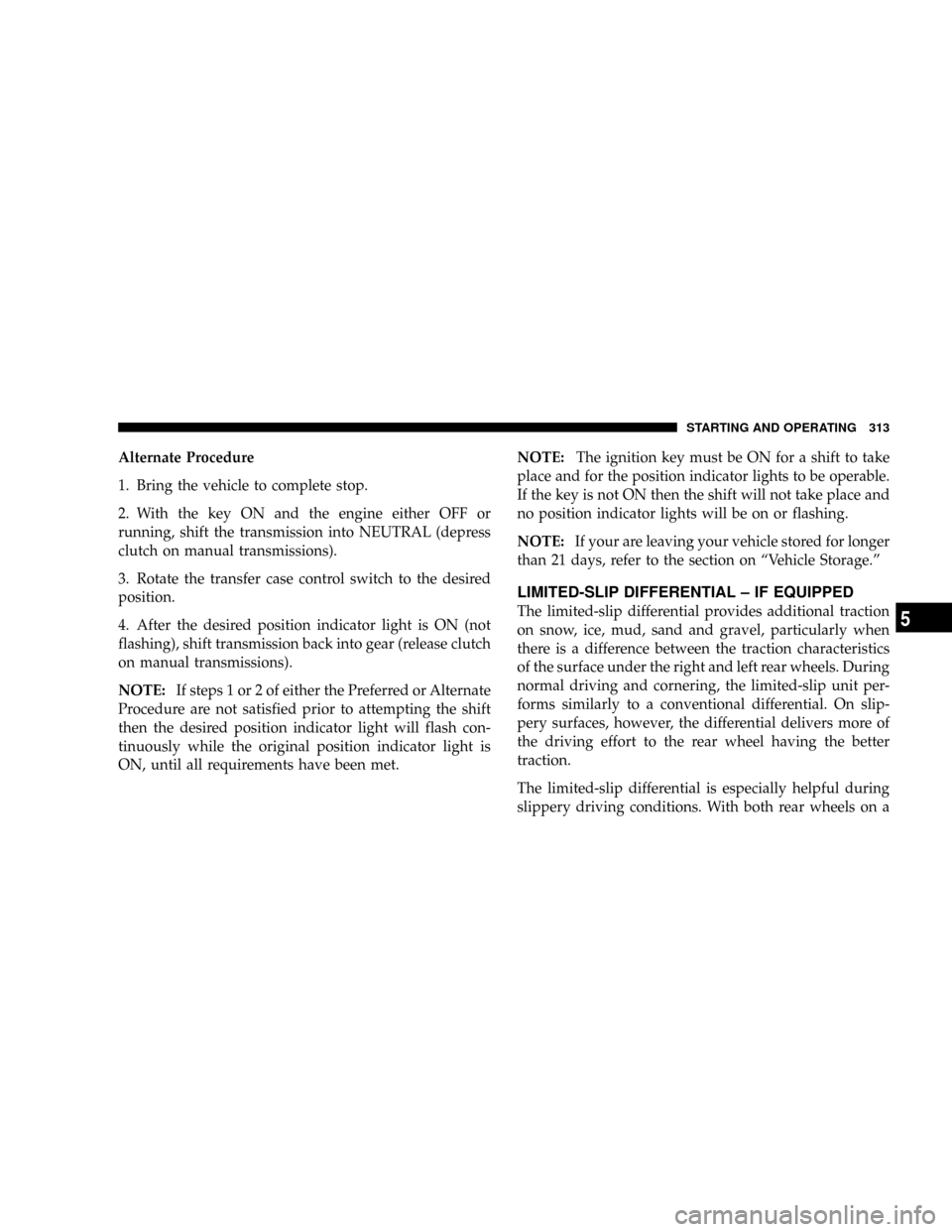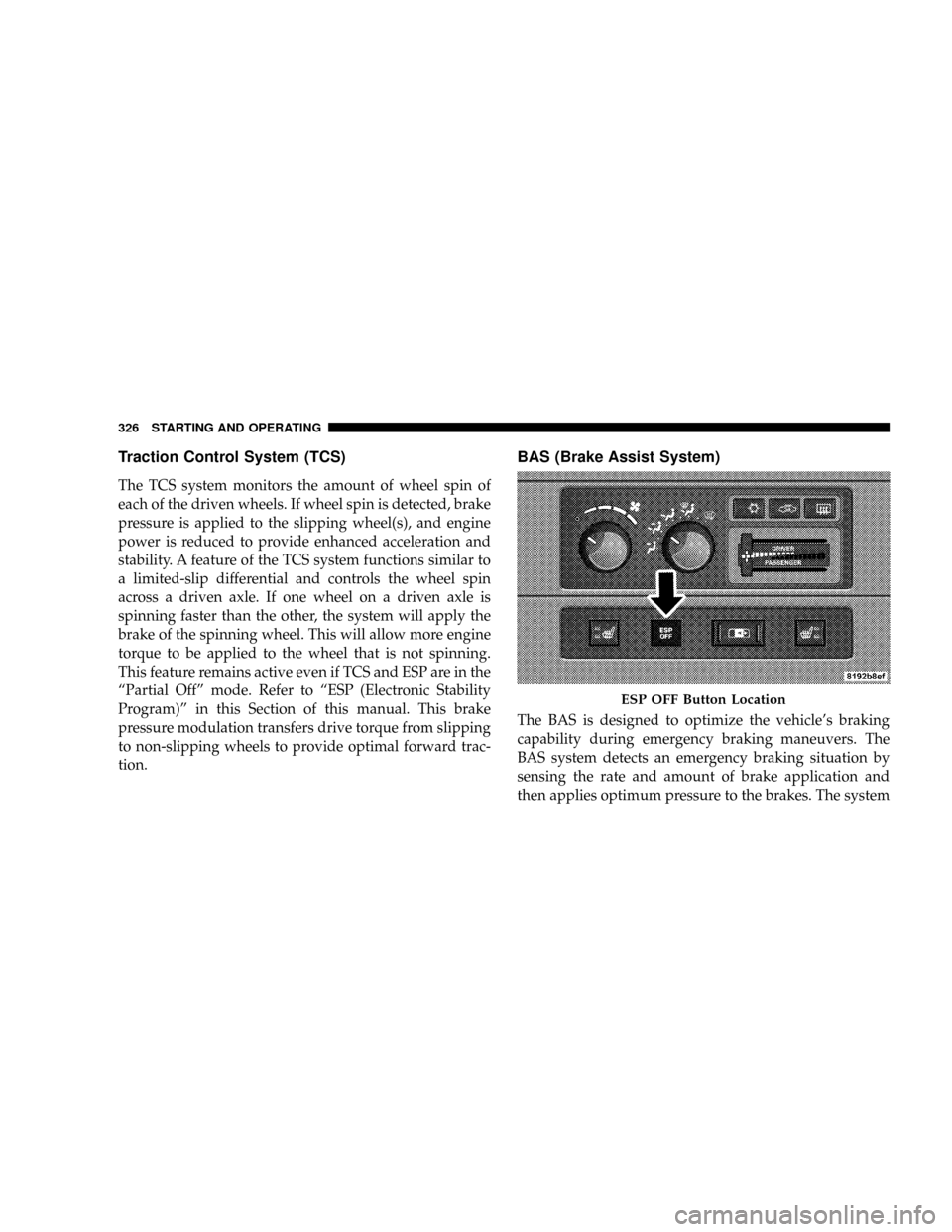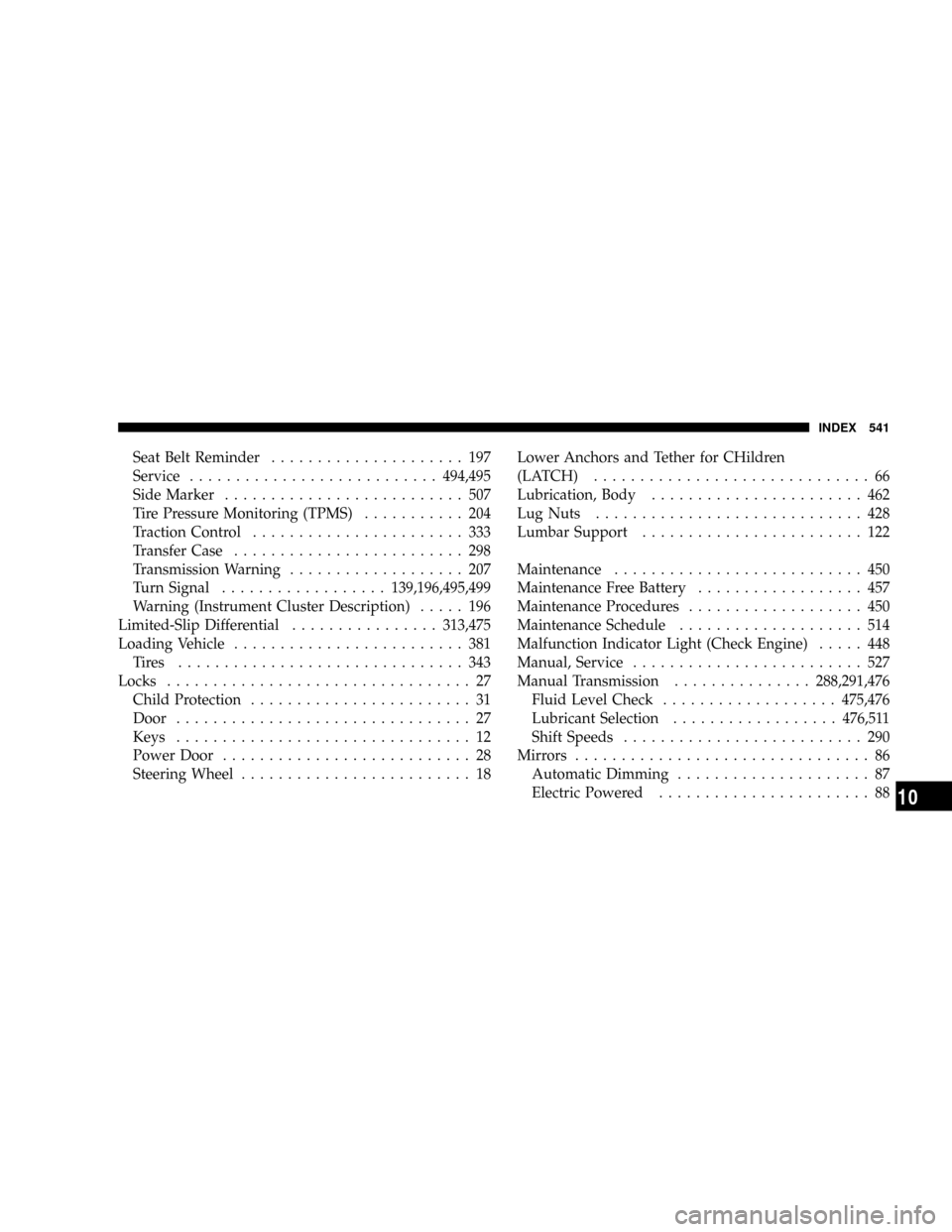2008 DODGE RAM 3500 GAS differential
[x] Cancel search: differentialPage 276 of 554

NTransfer Case Reminder Light............298
NElectronically Shifted Transfer Case Operating
Information/Precautions (5 Position Switch) Ð
If Equipped.........................298
NShifting Procedure Ð Electronically Shifted
Transfer Case........................304
NElectronically Shifted Transfer Case Operating
Information/Precautions (4 Position Switch) Ð
If Equipped.........................306
NShifting Procedure Ð Electronically Shifted
Transfer Case........................311
mLimited-Slip Differential ± If Equipped........313
mDriving On Slippery Surfaces..............314
mDriving Through Water..................315
NFlowing/Rising Water..................315mDriving Off-Road.......................317
mParking Brake.........................318
mBrake System..........................319
N3500 Dual Rear Wheel Models Only........320
NBrake Noise.........................320
NRear Wheel Anti-Lock (RWAL) Brake System Ð
If Equipped.........................320
NFour-Wheel Anti-Lock Brake System Ð
If Equipped.........................321
mPower Steering........................323
mElectronic Brake Control System
(ABS/TCS/BAS/HSA/ERM/ESP/TSC) Ð
If Equipped...........................324
NABS (Anti-Lock Brake System)............325
274 STARTING AND OPERATING
Page 315 of 554

Alternate Procedure
1. Bring the vehicle to complete stop.
2. With the key ON and the engine either OFF or
running, shift the transmission into NEUTRAL (depress
clutch on manual transmissions).
3. Rotate the transfer case control switch to the desired
position.
4. After the desired position indicator light is ON (not
flashing), shift transmission back into gear (release clutch
on manual transmissions).
NOTE:If steps 1 or 2 of either the Preferred or Alternate
Procedure are not satisfied prior to attempting the shift
then the desired position indicator light will flash con-
tinuously while the original position indicator light is
ON, until all requirements have been met.NOTE:The ignition key must be ON for a shift to take
place and for the position indicator lights to be operable.
If the key is not ON then the shift will not take place and
no position indicator lights will be on or flashing.
NOTE:If your are leaving your vehicle stored for longer
than 21 days, refer to the section on ªVehicle Storage.º
LIMITED-SLIP DIFFERENTIAL ± IF EQUIPPED
The limited-slip differential provides additional traction
on snow, ice, mud, sand and gravel, particularly when
there is a difference between the traction characteristics
of the surface under the right and left rear wheels. During
normal driving and cornering, the limited-slip unit per-
forms similarly to a conventional differential. On slip-
pery surfaces, however, the differential delivers more of
the driving effort to the rear wheel having the better
traction.
The limited-slip differential is especially helpful during
slippery driving conditions. With both rear wheels on a
STARTING AND OPERATING 313
5
Page 328 of 554

Traction Control System (TCS)
The TCS system monitors the amount of wheel spin of
each of the driven wheels. If wheel spin is detected, brake
pressure is applied to the slipping wheel(s), and engine
power is reduced to provide enhanced acceleration and
stability. A feature of the TCS system functions similar to
a limited-slip differential and controls the wheel spin
across a driven axle. If one wheel on a driven axle is
spinning faster than the other, the system will apply the
brake of the spinning wheel. This will allow more engine
torque to be applied to the wheel that is not spinning.
This feature remains active even if TCS and ESP are in the
ªPartial Offº mode. Refer to ªESP (Electronic Stability
Program)º in this Section of this manual. This brake
pressure modulation transfers drive torque from slipping
to non-slipping wheels to provide optimal forward trac-
tion.
BAS (Brake Assist System)
The BAS is designed to optimize the vehicle's braking
capability during emergency braking maneuvers. The
BAS system detects an emergency braking situation by
sensing the rate and amount of brake application and
then applies optimum pressure to the brakes. The system
ESP OFF Button Location
326 STARTING AND OPERATING
Page 436 of 554

HOISTING
A conventional floor jack may be used at the jacking
locations. Refer to the graphics that show jacking loca-
tions. However, a floor jack or frame hoist must never be
used on any other parts or the underbody.
CAUTION!
Never use a floor jack directly under the differential
housing of a loaded truck or damage to your vehicle
may result.
JUMP-STARTING PROCEDURES
Do not attempt to push or tow your vehicle to get it
started. Vehicles equipped with an automatic transmis-
sion cannot be started this way. Pushing or towing a
vehicle equipped with a manual transmission may over-
heat and damage the catalytic converter. Also, there is a
greater risk of an accident when a vehicle is being pushed
or towed. If the vehicle has a discharged battery, booster
cables may be used to obtain a start from a booster
battery or the battery in another vehicle. This type of start
can be dangerous if done improperly, so follow this
procedure carefully.
434 WHAT TO DO IN EMERGENCIES
Page 477 of 554

NOTE:The presence of water in the gear lubricant will
result in corrosion and possible failure of differential
components. Operation of the vehicle in water, as may be
encountered in some off-highway types of service, will
require draining and refilling the axle to avoid damage.
Limited-Slip Differentialsin 1500 Model vehicles re-
quire that 4 oz. (118 ml) Mopartlimited slip additive be
added to the gear lubricant. Refer to Fluids, Lubricants
and Genuine Parts for correct fluid type. The Mopart
Limited Slip Additive should be added to the gear
lubricant whenever a fluid change is made.
2500/3500 Model AxlesDO NOT REQUIREany limited
slip oil additive (friction modifiers).Transfer Case
Drain And Refill
Follow the Maintenance Schedule for recommended
transfer case fluid change intervals.
Lubricant Selection
For the correct Fluid type, refer to ªFluids, Lubricants
and Genuine Partsº in this Section.
Fluid Level Check
This fluid level can be checked by removing the filler
plug. The fluid level should be to the bottom edge of the
filler plug hole with the vehicle in a level position.
MAINTAINING YOUR VEHICLE 475
7
Page 537 of 554

Pressure Cap......................... 468
Radiator Cap......................... 468
Selection of Coolant (Antifreeze)......466,508,510
Temperature Gauge..................... 198
Cruise Control (Speed Control).............. 145
Cupholders............................ 169
Customer Assistance..................... 523
Data Recorder, Event...................... 60
Daytime Running Lights................... 137
Dealer Service.......................... 450
Defroster, Rear Window.................89,182
Defroster, Windshield................79,260,263
Delay (Intermittent) Wipers................. 141
Differential, Limited-Slip.................. 313
Dipsticks
Automatic Transmission................. 477
Power Steering........................ 460
Disc Brakes............................ 471Disposal
Antifreeze (Engine Coolant)............... 469
Door Locks............................. 27
Door Opener, Garage..................... 156
Drive Belts............................ 454
Drive Shaft Universal Joints................ 461
Driving
Through Flowing, Rising, or Shallow Standing
Water................................ 315
Dual Rear Wheels.....................361,431
DVD Player (Video Entertainment SystemŸ).... 251
E-85 Fuel............................. 377
Electric Rear Window Defrost.............89,182
Electrical Power Outlets................... 166
Electronic Brake Control System............. 324
Anti-Lock Brake System................. 325
Brake Assist System.................... 326
Electronic Roll Mitigation................ 332
INDEX 535
10
Page 539 of 554

Filters
Air Cleaner........................455,481
Engine Fuel.......................... 455
Engine Oil........................454,510
Engine Oil Disposal.................... 453
Flashers
Turn Signal.......................... 139
Flat Tire Stowage.....................422,433
Flexible Fuel Vehicles
Cruising Range........................ 380
Engine Oil........................... 380
Fuel Requirements..................377,379
Replacement Parts..................... 381
Starting............................. 380
Flooded Engine Starting................... 280
Fluid, Brake............................ 511
Fluid Capacities......................... 508
Fluid Level Checks
Automatic Transmission................. 477Brake............................... 472
Power Steering........................ 460
Fluids, Lubricants and Genuine Parts.......... 510
Fog Lights.......................138,201,498
Fold Flat Load Floor..................... 179
Four Wheel Drive....................... 294
Four-Way Hazard Flasher.................. 416
Freeing A Stuck Vehicle................... 437
Front Axle (Differential)................... 474
Front Wheel Bearings..................... 479
Fuel................................. 371
Adding............................. 375
Filler Cap (Gas Cap).................... 377
Filter............................... 455
Gauge.............................. 207
Hoses.............................. 471
Octane Rating......................371,510
Requirements......................371,508
System Hoses......................... 471
INDEX 537
10
Page 543 of 554

Seat Belt Reminder..................... 197
Service...........................494,495
Side Marker.......................... 507
Tire Pressure Monitoring (TPMS)........... 204
Traction Control....................... 333
Transfer Case......................... 298
Transmission Warning................... 207
Turn Signal..................139,196,495,499
Warning (Instrument Cluster Description)..... 196
Limited-Slip Differential................313,475
Loading Vehicle......................... 381
Tires ............................... 343
Locks................................. 27
Child Protection........................ 31
Door................................ 27
Keys................................ 12
Power Door........................... 28
Steering Wheel......................... 18Lower Anchors and Tether for CHildren
(LATCH).............................. 66
Lubrication, Body....................... 462
Lug Nuts............................. 428
Lumbar Support........................ 122
Maintenance........................... 450
Maintenance Free Battery.................. 457
Maintenance Procedures................... 450
Maintenance Schedule.................... 514
Malfunction Indicator Light (Check Engine)..... 448
Manual, Service......................... 527
Manual Transmission...............288,291,476
Fluid Level Check...................475,476
Lubricant Selection..................476,511
Shift Speeds.......................... 290
Mirrors................................ 86
Automatic Dimming..................... 87
Electric Powered....................... 88
INDEX 541
10